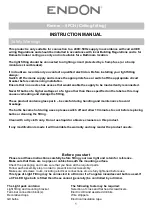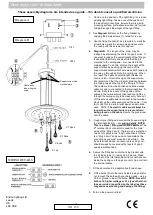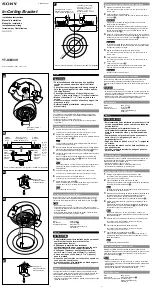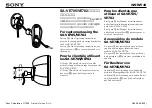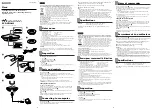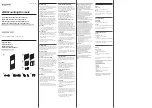
2
Assembly/ User Instructions
These assembly diagrams are intended as a guide – if in doubt consult a qualified electrician.
Y11 139
Diagram A
1.
Decide on the position of the light fitting / or remove
existing light fitting. Take a note of the position of
the electrical connections. Ensure there is a solid
mounting surface, preferably a wooden joist or joist
bridge to support the weight of the light fitting.
2. See
Diagram A
. Remove the fixing bracket by
undoing the 2 side screws (1), retain for re-use.
3. Use the fixing bracket (2) as a template to mark the
screw holes, mark the screw holes and secure to
the ceiling with the screws (3) supplied.
4.
Diagram B
. The length of the `drop` may be
reduced by shortening the cable / support wires. If
you want to reduce the overall length of the fitting it
is essential that this is done before the fitting is
mounted to the ceiling and / or connected to the
mains supply. To do this, shorten the length of the
support wires by pushing up the centre of the
support mechanism (which acts as a clutch) and pull
the wire up through and into the ceiling cup. When
you reach the desired overall length release the
centre clutch – this will then grip the support wire.
We recommend that the minimum distance between
the ceiling cup and the top of the fitting is 100mm.
The cable must now be shortened and the excess
cable cut and re-connected to the terminal block. To
do this, firstly take a note of the position of the
cables in the terminal block then feed the cable up
through the ceiling cup (grub screw) entry hole, cut
off the excess cable and re-connect to the terminal
block. Move the cable anchor down the cable – from
(A) to (B).This is a strain relief device and must be
used. NOTE:
The electric cable must always be
longer than the support wire to prevent strain
being placed on the cable
. Secure the grub screw
onto the cable.
5. Support your fitting and connect the house wiring to
the terminal block (4) – see
wiring details. NOTE:
This is a Class I fitting and
must be earthed
. The
4
th
terminal block connector is used for the “loop”
wires of the “Ring Circuit”. There may be more than
one set of cables in the “loop” connections. If there
is a “Ring Circuit” and you do not understand the
connections you must consult an electrician. Any
loose terminal blocks –not secured to ceiling cup -
should always be covered with 2 layers of good
quality insulation tape.
6.
Secure the fitting back onto the fixing bracket with
the 2 side screws (1), removed in 2 above. Make
sure that all the internal cables and connections are
inside the ceiling cup taking care not to trap or strain
the internal cables.
7. Fit the decorative drop assemblies (5) as shown.
8.
Fit the bulbs (6) into the lamp holders being careful
not to touch the bulbs with your bare hands – use a
cloth or gloves to insert the bulbs.
NOTE; Never fit
bulbs of a higher wattage or of a type other than
those provided / specified on the label (as these
may cause overheating and damage the fitting).
9.
T
urn on the power and test.
Diagram B
Endon lighting Ltd.
Leeds.
UK
LS9 0SE
WIRING DETAILS
Cable entry
tube with grub
screw
Support wire clutch
mechanisms
X 15pcs
X 10pcs
X 5pcs
X 1pc
(A)
(B)

